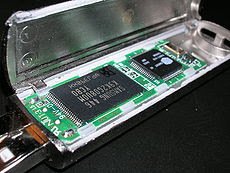

Execution and storage
Typically, computer programs are stored in non-volatile memory until requested either directly or indirectly to be executed by the computer user. Upon such a request, the program is loaded into random access memory, by a computer program called an operating system, where it can be accessed directly by the central processor. The central processor then executes ("runs") the program, instruction by instruction, until termination. A program in execution is called a process. Termination is either by normal self-termination or by error — software or hardware error.
Embedded programs
The microcontroller on the right of this USB flash drive is controlled with embedded firmware.
Some computer programs are embedded into hardware. A stored-program computer requires an initial computer program stored in its read-only memory to boot. The boot process is to identify and initialize all aspects of the system, from CPU registers to device controllers to memory contents. Following the initialization process, this initial computer program loads the operating system and sets the program counter to begin normal operations. Independent of the host computer, a hardware device might have embedded firmware to control its operation. Firmware is used when the computer program is rarely or never expected to change, or when the program must not be lost when the power is off.
Manual programming
Switches for manual input on a Data General Nova 3
Computer programs historically were manually input to the central processor via switches. An instruction was represented by a configuration of on/off settings. After setting the configuration, an execute button was pressed. This process was then repeated. Computer programs also historically were manually input via paper tape or punched cards. After the medium was loaded, the starting address was set via switches and the execute button pressed.
Automatic program generation
Generative programming is a style of computer programming that creates source code through generic classes, prototypes, templates, aspects, and code generators to improve programmer productivity. Source code is generated with programming tools such as a template processor or an Integrated Development Environment. The simplest form of source code generator is a macro processor, such as the C preprocessor, which replaces patterns in source code according to relatively simple rules.
Software engines output source code or markup code that simultaneously become the input to another computer process. The analogy is that of one process driving another process, with the computer code being burned as fuel. Application servers are software engines that deliver applications to client computers. For example, a Wiki is an application server that allows users to build dynamic content assembled from articles. Wikis generate HTML, CSS, Java, and Javascript which are then interpreted by a web browser.
Simultaneous execution
See also: Process (computing) and Multiprocessing
Many operating systems support multitasking which enables many computer programs to appear to be running simultaneously on a single computer. Operating systems may run multiple programs through process scheduling — a software mechanism to switch the CPU among processes frequently so that users can interact with each program while it is running. Within hardware, modern day multiprocessor computers or computers with multicore processors may run multiple programs.
Functional categories
Computer programs may be categorized along functional lines. These functional categories are system software and application software. System software includes the operating system which couples the computer's hardware with the application software.The purpose of the operating system is to provide an environment in which application software executes in a convenient and efficient manner. In addition to the operating system, system software includes utility programs that help manage and tune the computer. If a computer program is not system software then it is application software. Application software includes middleware, which couples the system software with the user interface. Application software also includes utility programs that help users solve application problems, like the need for sorting.
Source: http://en.wikipedia.org/wiki/Computer_program


No comments:
Post a Comment